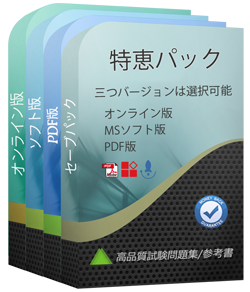あなたはAssociate-Developer-Apache-Spark-3.5試験参考書の更新をどのぐらいでリリースしていますか?
すべての試験参考書は常に更新されますが、固定日付には更新されません。弊社の専門チームは、試験のアップデートに十分の注意を払い、彼らは常にそれに応じてAssociate-Developer-Apache-Spark-3.5試験内容をアップグレードします。
購入後、どれくらいAssociate-Developer-Apache-Spark-3.5試験参考書を入手できますか?
あなたは5-10分以内にDatabricks Associate-Developer-Apache-Spark-3.5試験参考書を付くメールを受信します。そして即時ダウンロードして勉強します。購入後にAssociate-Developer-Apache-Spark-3.5試験参考書を入手しないなら、すぐにメールでお問い合わせください。
Associate-Developer-Apache-Spark-3.5テストエンジンはどのシステムに適用しますか?
オンラインテストエンジンは、WEBブラウザをベースとしたソフトウェアなので、Windows / Mac / Android / iOSなどをサポートできます。どんな電設備でも使用でき、自己ペースで練習できます。オンラインテストエンジンはオフラインの練習をサポートしていますが、前提条件は初めてインターネットで実行することです。
ソフトテストエンジンは、Java環境で運行するWindowsシステムに適用して、複数のコンピュータにインストールすることができます。
PDF版は、Adobe ReaderやFoxit Reader、Google Docsなどの読書ツールに読むことができます。
割引はありますか?
我々社は顧客にいくつかの割引を提供します。 特恵には制限はありません。 弊社のサイトで定期的にチェックしてクーポンを入手することができます。
あなたのテストエンジンはどのように実行しますか?
あなたのPCにダウンロードしてインストールすると、Databricks Associate-Developer-Apache-Spark-3.5テスト問題を練習し、'練習試験'と '仮想試験'2つの異なるオプションを使用してあなたの質問と回答を確認することができます。
仮想試験 - 時間制限付きに試験問題で自分自身をテストします。
練習試験 - 試験問題を1つ1つレビューし、正解をビューします。
Tech4Examはどんな試験参考書を提供していますか?
テストエンジン:Associate-Developer-Apache-Spark-3.5試験試験エンジンは、あなた自身のデバイスにダウンロードして運行できます。インタラクティブでシミュレートされた環境でテストを行います。
PDF(テストエンジンのコピー):内容はテストエンジンと同じで、印刷をサポートしています。
返金するポリシーはありますか? 失敗した場合、どうすれば返金できますか?
はい。弊社はあなたが我々の練習問題を使用して試験に合格しないと全額返金を保証します。返金プロセスは非常に簡単です:購入日から60日以内に不合格成績書を弊社に送っていいです。弊社は成績書を確認した後で、返金を行います。お金は7日以内に支払い口座に戻ります。
更新されたAssociate-Developer-Apache-Spark-3.5試験参考書を得ることができ、取得方法?
はい、購入後に1年間の無料アップデートを享受できます。更新があれば、私たちのシステムは更新されたAssociate-Developer-Apache-Spark-3.5試験参考書をあなたのメールボックスに自動的に送ります。
Databricks Certified Associate Developer for Apache Spark 3.5 - Python 認定 Associate-Developer-Apache-Spark-3.5 試験問題:
1. A data engineer noticed improved performance after upgrading from Spark 3.0 to Spark 3.5. The engineer found that Adaptive Query Execution (AQE) was enabled.
Which operation is AQE implementing to improve performance?
A) Collecting persistent table statistics and storing them in the metastore for future use
B) Dynamically switching join strategies
C) Improving the performance of single-stage Spark jobs
D) Optimizing the layout of Delta files on disk
2. The following code fragment results in an error:
@F.udf(T.IntegerType())
def simple_udf(t: str) -> str:
return answer * 3.14159
Which code fragment should be used instead?
A) @F.udf(T.IntegerType())
def simple_udf(t: int) -> int:
return t * 3.14159
B) @F.udf(T.DoubleType())
def simple_udf(t: float) -> float:
return t * 3.14159
C) @F.udf(T.DoubleType())
def simple_udf(t: int) -> int:
return t * 3.14159
D) @F.udf(T.IntegerType())
def simple_udf(t: float) -> float:
return t * 3.14159
3. A data scientist is working on a project that requires processing large amounts of structured data, performing SQL queries, and applying machine learning algorithms. The data scientist is considering using Apache Spark for this task.
Which combination of Apache Spark modules should the data scientist use in this scenario?
Options:
A) Spark DataFrames, Structured Streaming, and GraphX
B) Spark DataFrames, Spark SQL, and MLlib
C) Spark Streaming, GraphX, and Pandas API on Spark
D) Spark SQL, Pandas API on Spark, and Structured Streaming
4. A developer wants to refactor some older Spark code to leverage built-in functions introduced in Spark 3.5.0.
The existing code performs array manipulations manually. Which of the following code snippets utilizes new built-in functions in Spark 3.5.0 for array operations?
A)
B)
C)
D)
A) result_df = prices_df \
.agg(F.count("spot_price").alias("spot_price")) \
.filter(F.col("spot_price") > F.lit("min_price"))
B) result_df = prices_df \
.withColumn("valid_price", F.when(F.col("spot_price") > F.lit(min_price), 1).otherwise(0))
C) result_df = prices_df \
.agg(F.min("spot_price"), F.max("spot_price"))
D) result_df = prices_df \
.agg(F.count_if(F.col("spot_price") >= F.lit(min_price)))
5. A Spark DataFramedfis cached using theMEMORY_AND_DISKstorage level, but the DataFrame is too large to fit entirely in memory.
What is the likely behavior when Spark runs out of memory to store the DataFrame?
A) Spark duplicates the DataFrame in both memory and disk. If it doesn't fit in memory, the DataFrame is stored and retrieved from the disk entirely.
B) Spark stores the frequently accessed rows in memory and less frequently accessed rows on disk, utilizing both resources to offer balanced performance.
C) Spark splits the DataFrame evenly between memory and disk, ensuring balanced storage utilization.
D) Spark will store as much data as possible in memory and spill the rest to disk when memory is full, continuing processing with performance overhead.
質問と回答:
| 質問 # 1 正解: B | 質問 # 2 正解: B | 質問 # 3 正解: B | 質問 # 4 正解: D | 質問 # 5 正解: D |


 弊社は製品に自信を持っており、面倒な製品を提供していません。
弊社は製品に自信を持っており、面倒な製品を提供していません。



 -Akiyama
-Akiyama

